Litvak Dance Offers Spellbinding Premieres
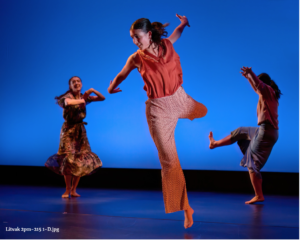
Erica Ruse, Jacqueleen Schweighardt, Hannah Wyer in “Bayit.” Photo: Jim Carmody
Sadie Weinberg’s vision for Litvak Dance, her four-year-old company, is to attract top choreographers to create work for her powerhouse dancers. For Litvak’s performance last weekend, Weinberg assembled an international dream team. The show featured spellbinding premieres by Israeli dancemaker Ronen Izhaki and rising New York star Rebecca Margolick.
The program at San Dieguito Academy High School also offered a painterly dance by Issa Hourani and restagings of two favorites: a delightfully camp piece by L.A.’s WHYTEBERG and a dance by Weinberg from the company’s inaugural show in 2018.
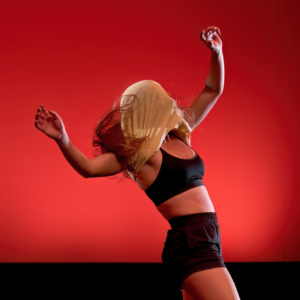
Ashley Akhavan in “Every Single Grain of Rice.” Photo: Jim Carmody
Izhaki, head of the Movement Department at the Jerusalem Academy of Music and Dance, grounded “Every Grain of Rice,” in the dancers’ family histories. He and musician Kristopher Apple collaborated on a superb spoken-word score of excerpts from the seven dancers’ recorded stories. They’re heard mostly one at a time, with that dancer doing moves beautifully tailored to each one.
Nick McGhee commands the space with powerful, long-limbed extensions as we hear about his grandfather, the shaman in his village in Colombia. Ashley Ahkavan, whose Iranian grandmother wore a veil, staggers and pull her shirt up over face—ironically, becoming more exposed in her bra-top than with her face uncovered. Delicate, stork-like balances accompany Hannah Wyer’s story of her Japanese family teaching her about the importance of rice.
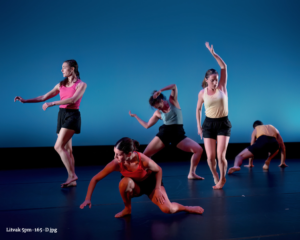
“Every Single Grain of Rice.” Photo: Jim Carmody
At times, everyone groups—flocking to a corner, twisting into sculptural shapes, crouching low and shifting their weight side to side. In an impossibly graceful moment, Jordan Daley lifts one leg in a high extension and rests his foot on McGhee’s forehead.
Apple, onstage, offers live violin, percussion effects, and sometimes silence. Near the end of the piece, there’s a recording of Ennio Morricone’s “The Good, the Bad, and the Ugly.” Huh? It’s a baffling choice, yet the piece coheres brilliantly, flowing from one story to the next, endlessly fascinating.
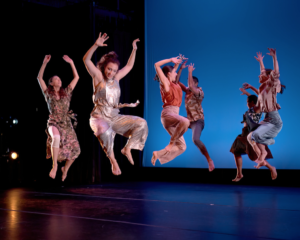
“Bayit.” Photo: Jim Carmody
Another dazzling premiere came from Margolick, one of Dance Magazine‘s “25 to Watch” in 2021. “Bayit” will be the final section of “Light,” an evening-length Litvak work with original music by klezmer artist/scholar Yale Strom that premieres next month.
“Bayit” opens in stillness and silence. Seven dancers form a loose group, several sitting on the floor, all of them motionless. Then Erica Ruse drums her chest, Emily Miller picks up the rhythm with a heel drop, and everyone begins to stir.
Holding hands in a jagged suggestion of a circle , they stomp their feet and quickly change direction. (The piece was inspired by Yiddish folk dances.) Then the musicians—Pete Polansky and Matt Henson on violin and bass—strike up a rollicking klezmer tune. Eyes meet. Smiles ignite. People partner in twos and threes. Dancers yip and exuberantly fling their arms and legs. They jump!
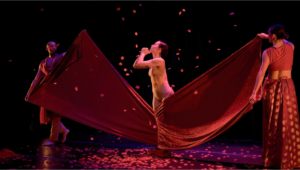
Jacqueleen Schweighardt, Hannah Wyer, Jordan Daley. Photo: Jim Carmody
Hourani, a Mexican-Jordanian artist based in Long Beach, drew on Middle Eastern rituals for “all I left you.” A feast of color and texture, the piece opens with Wyer in a full red skirt that whips around her legs to text about being tumbled by a wave. (The text is from Kristin Idaszak’s play “Second Skin,” recorded by Akhavan.) Is this about a drowning? Surely, a death is happening as Wyer gets tangled in the skirt, struggles with it, and eventually strips to flesh-colored bra and panties, while “rose petals” fall from above and we hear tolling bells.
In a second section, Daley and Jacqueleen Schweighardt seem to be mourners, resplendent in scarlet and saffron. (Hourani and Betzi Roe did the lovely costumes, whose style struck me as Indian.) Daley picks up the discarded skirt and smites his chest, as Schweighardt draws a length of red fabric across the stage. Wyer returns, and they slowly wrap the fabric around her.
There’s a lot of playing with fabric and standing gravely; I wanted more dance. Still, this piece offers gorgeous visuals.
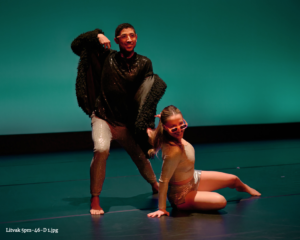
Nick McGhee, Ashley Akhavan. Photo: Jim Carmody
When Litvak premiered WHYTEBERG’s “I hear everybody you know is more relevant than everybody I know,” in July, it was a study in incongruity, putting clubby vamping (by Akhavan and McGhee) in a sunlit garden. The theater proved a more apt, if less amusing, setting.
Four dancers enter into careful partnering, as if comforting one another after a loss, in “We Find Home,” Weinberg’s darkly lit, lyrical dance from Litvak’s first show. It’s interesting that Margolick’s “Bayit”—Hebrew for home—will close the new evening-length “Light.” Between the earlier home and the joyous “Bayit,” I know where I’d choose to live.
“Light” will run Sunday, December 18 at 2 pm and 7 pm at the Lawrence Family JCC.
A personal note to dance presenters: This fall, I planned to attend two shows after being assured they would require the audience to wear masks, but then didn’t go. One company gave me a heads-up that they decided to relax their mask policy; with the other, I entered the theater, found out masks were optional, and left. Litvak made one of their performances mask-required … and got a full house. I wish others would follow their lead.

Award-winning dance journalist Janice Steinberg has published more than 400 articles in the San Diego Union-Tribune, Dance Magazine, the Los Angeles Times, and elsewhere. She was a 2004 New York Times-National Endowment for the Arts fellow at the Institute for Dance Criticism and has taught dance criticism at San Diego State University. She is also a novelist, author of The Tin Horse (Random House, 2013). For why she’s passionate about dance, see this article on her web site, The Tin Horse

Janice: much appreciation for your thoughtful insights and commentary – dance writers provide an important service to the field and it’s a tragedy for creators and performers that the profession is imploding. We are really glad that there are still people like you paying attention. Feedback is a gift.
We attended and enjoyed the concert, your review made it come alive a second time.